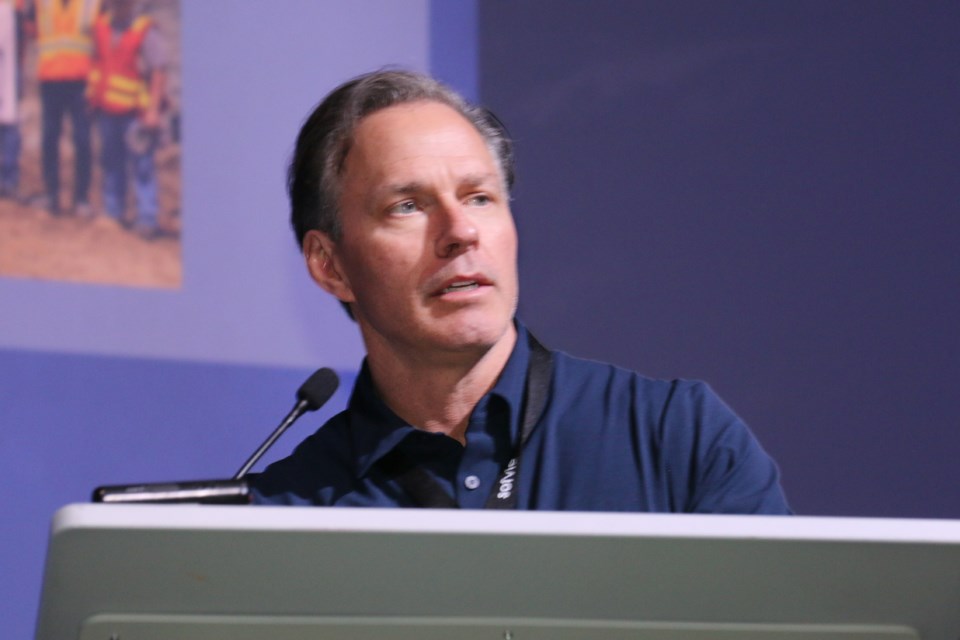Two well-known mining executives in Sudbury talked about the importance of inspiring people to work safely, not just because it's the right thing to do, but also because people who feel safe about their work are likely to perform better.
Gus Minor, chief operating officer at Sofvie Inc. in Sudbury, was joined by Chris Bamberger, a mining operations consultant, at the Workplace Safety North 27th annual mining conference held last week.
Bamberger, who is also a member of the WSN mining advisory committee, asked his audience to name the best traits of good leaders and people. He was given answers such as compassion, trust, clear communications, support, commitment and purpose.
He said all the answers were exactly what people expect.
He said the best traits in any workplace boil down to three factors where people feel safe, feel significant and feel situated.
Bamberger explained that safety, for example, goes beyond the physical state of safety that workers strive for.
"But it's more than that, isn't it? It extends to mental safety, psychological safety, emotional safety, social safety, right?" said Bamberger.
"It's about creating that environment where people feel secure, to speak up, to contribute ideas, to admit mistakes without fear and raise health and safety concerns, and trust is a byproduct of feeling truly safe," he added.
In a mining environment, Bamberger said conditions change constantly and quickly.
If workers don't feel psychologically, socially, mentally safe, they may not raise their hand to stop an unsafe job or even speak out, said Bamberger.
He also commented on how every worker needs to be regarded as a key player on the team. They must feel proud to belong to that team.
"Think about a newly trained scoop operator, or jumbo driller. If they don't feel like the role is essential to the team, how likely are they going to fully do their own work in mining? Every role matters," said Bamberger.
Speaking on the importance of a "situated worker," Bamberger said the worker has a clear understanding of their work, why their work is important to the company and what is expected on the job.
Bamberger said when all three elements of being safe, significant and situated come together, it creates a strong worker on a strong team.
"That's why I asked you to think about when you were on a team, or had a leader that truly inspired you. You're absolutely unstoppable. Energy is high, focus sharpens, commitment skyrockets," he said.
Bamberger said it's not only for the good times, but also for when something goes wrong. Strong workers know what to do to move forward, solve problems and get the job done, he said.
Sofvie executive Gus Minor said with mining being a global business he found it interesting how safety performances can differ greatly in Canada, the U.S. and other countries around the world, even within the same companies.
In many cases, he said, it can be tied directly to the basic safety requirements in each country, which is the minimum requirement for workplace safety.
Minor said it was important for employers to get employees more engaged in workplace safety so they would be inspired to do better.
He said he often asks people how many health and safety professionals their company has. Minor said the usual answer is five or six people.
In fact, said Minor, the right answer is that if you have 500 workers, then you have 500 health and safety professionals.
"Just because you've got one that's accountable to make sure that the programs are maintained, it doesn't mean that you create a scenario where nobody has a voice. If you give everybody a voice in the organization, you've got 500 health and safety professionals helping you out with your journey," said Minor.
Minor said it is not just enough to know about good safety management practices but to make sure they're implemented throughout the company, regardless of where you work or what country you live in.
"There's a lot of management conversations that you can put in place to make sure everything manages in the same alignment direction, so that in an organization, you don't have one manager that's awesome, that's doing certain things, and another one that's totally not."
He said those sorts of inconsistencies will cause the best teams to separate.
"So getting those alignment sessions with managers, supervisors, throughout the same teaching workforce, that continues the conversation to make sure everybody is marching in the right direction,” said Minor.
Len Gillis covers health care and mining for Sudbury.com.




